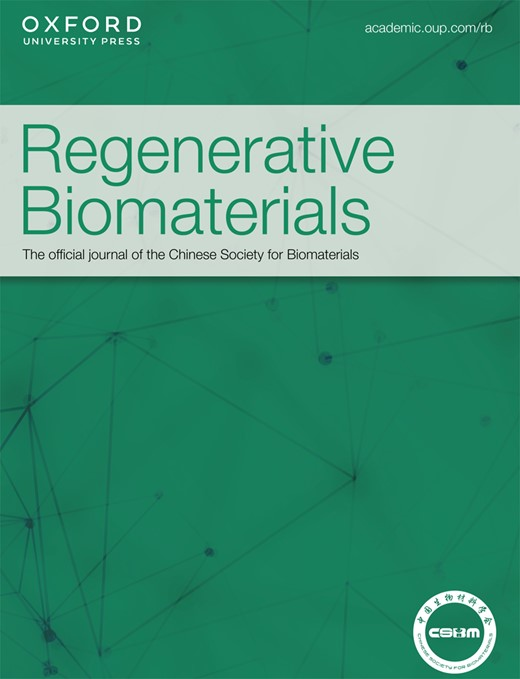Yolk-Shelled silver nanowire@amorphous Metal-Organic framework for controlled drug delivery and Light-Promoting infected wound healing
IF 5.6
1区 医学
Q1 MATERIALS SCIENCE, BIOMATERIALS
引用次数: 0
Abstract
Bacteria-infected wounds healing has been greatly hindered by antibiotic resistance and persistent inflammation. It is crucial to develop multifunctional nanocomposites that possess effective antibacterial properties and can simultaneously accelerate the wound healing process to overcome the above challenges. Herein, we prepared a yolk-shell structured Ag nanowires (NWs)@amorphous hollow ZIF-67 by etching ZIF-67 onto the Ag NWs for infected wound healing for the first time. The etched hollow structure of amorphous ZIF-67 in the nanocomposite makes it a promising platform for loading healing-promoting drugs. We extensively studied the antibacterial and healing-promoting properties of the curcumin (CCM)-loaded nanocomposite (Ag NWs@C-HZ67). Ag NWs, being noble metal materials with plasmonic effects, can absorb a broad range of natural light and convert it to thermal energy. This photothermal conversion further improves the release of antibacterial components and wound healing drugs when exposed to light. During the healing process of an infected wound, Ag and Co ions were released from Ag NWs@C-HZ67 upon direct contact with the wound exudate and under the influence of light irradiation. Simultaneously, the loaded CCM leaked out to repair the infected wound. The minimum inhibitory concentrations of the Ag NWs@C-HZ67 groups against E. coli and S. aureus bacteria decreased to 3 and 3 μg mL−1 when exposed to white light. Furthermore, an in vivo assessment of infected wound healing demonstrated that combining Ag NWs@C-HZ67 with light significantly accelerated the wound healing process, achieving 70% healing by the 6th day and almost complete healing by the 8th day. This advanced nanocomposite, consisting of components that possess antibacterial and growth-promoting properties, offers a safe, effective, and clinically-translatable solution for accelerating the healing process of infected wounds.卵黄壳银纳米线@非晶态金属有机框架用于控制药物输送和光促进感染伤口愈合
细菌感染伤口的愈合受到抗生素耐药性和持续炎症的严重阻碍。开发具有有效抗菌性能并能同时加速伤口愈合过程的多功能纳米复合材料对克服上述挑战至关重要。在此,我们首次将 ZIF-67 刻蚀到 Ag 纳米线上,制备了卵黄壳结构的 Ag 纳米线(NWs)@非晶空心 ZIF-67,用于感染性伤口的愈合。纳米复合材料中无定形 ZIF-67 的蚀刻空心结构使其成为一个装载促进伤口愈合药物的理想平台。我们广泛研究了姜黄素(CCM)负载纳米复合材料(Ag NWs@C-HZ67)的抗菌和促进愈合性能。作为具有等离子效应的贵金属材料,Ag NWs 可吸收多种自然光并将其转化为热能。在光照下,这种光热转换可进一步改善抗菌成分和伤口愈合药物的释放。在感染伤口的愈合过程中,Ag NWs@C-HZ67 与伤口渗出物直接接触并在光照射的影响下释放出 Ag 和 Co 离子。与此同时,负载的 CCM 也渗出修复感染的伤口。在白光照射下,Ag NWs@C-HZ67 组对大肠杆菌和金黄色葡萄球菌的最小抑菌浓度分别降至 3 和 3 μg mL-1。此外,对感染伤口愈合的体内评估表明,Ag NWs@C-HZ67 与光的结合可显著加速伤口愈合过程,在第 6 天达到 70% 的愈合率,第 8 天几乎完全愈合。这种先进的纳米复合材料由具有抗菌和促进生长特性的成分组成,为加速感染伤口的愈合过程提供了一种安全、有效且可临床转化的解决方案。
本文章由计算机程序翻译,如有差异,请以英文原文为准。
求助全文
约1分钟内获得全文
求助全文
来源期刊

Regenerative Biomaterials
Materials Science-Biomaterials
CiteScore
7.90
自引率
16.40%
发文量
92
审稿时长
10 weeks
期刊介绍:
Regenerative Biomaterials is an international, interdisciplinary, peer-reviewed journal publishing the latest advances in biomaterials and regenerative medicine. The journal provides a forum for the publication of original research papers, reviews, clinical case reports, and commentaries on the topics relevant to the development of advanced regenerative biomaterials concerning novel regenerative technologies and therapeutic approaches for the regeneration and repair of damaged tissues and organs. The interactions of biomaterials with cells and tissue, especially with stem cells, will be of particular focus.
 求助内容:
求助内容: 应助结果提醒方式:
应助结果提醒方式:


